Townsend Courtney M.Jr., Evers B. Mark. Atlas of General Surgical Techniques: Expert Consult
Подождите немного. Документ загружается.

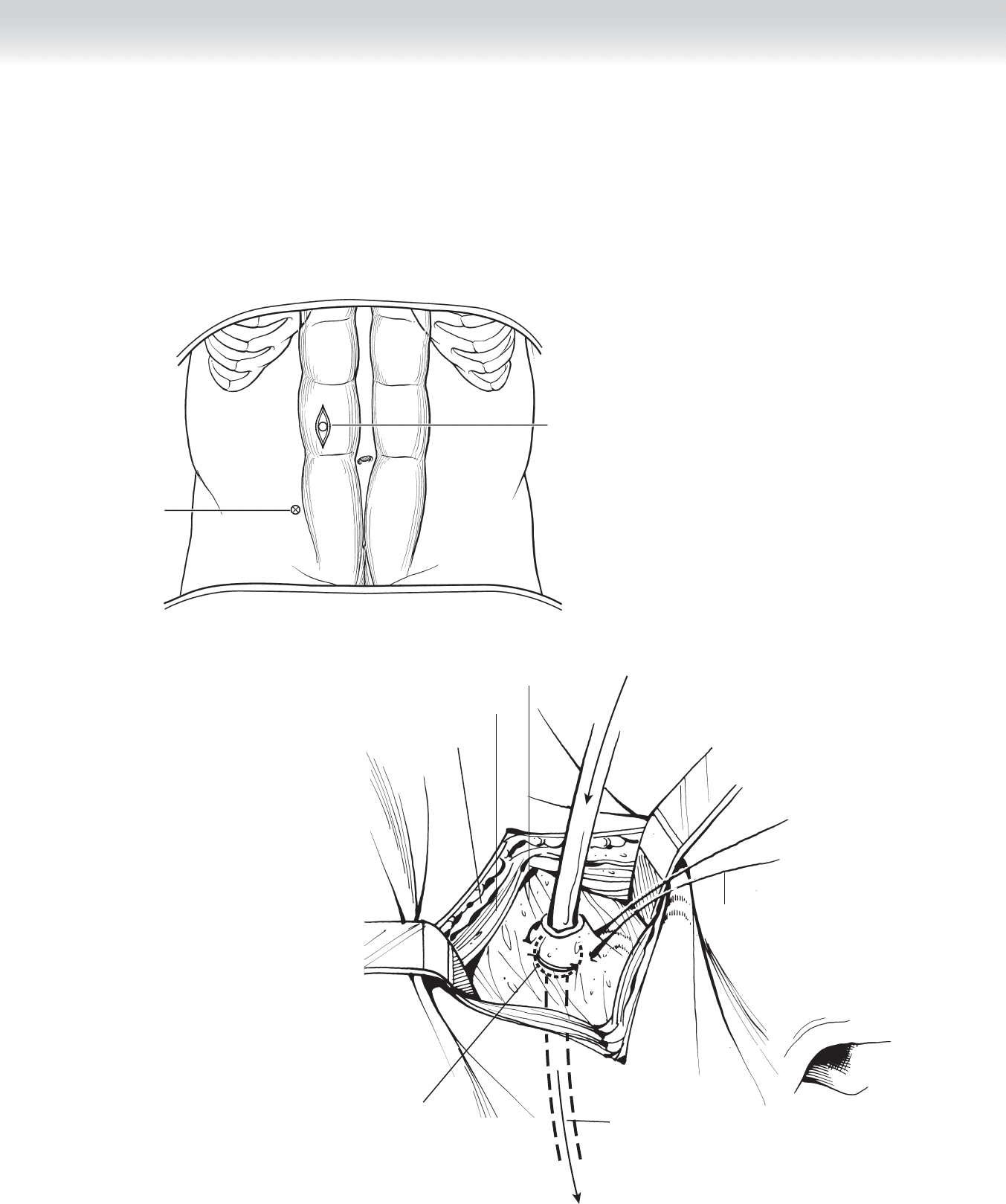
CHAPTER 91 • Insertion of Tenckhoff Catheter 1011
◆ If you are performing an open procedure without the aid of the laparoscope, carry the inci-
sion down through the skin and subcutaneous tissues to the muscle (Figure 91-2). Incise
the fascia of the muscle and split it down to the posterior fascia. Place a purse-string suture
in the fascia with the diameter approximately the size of a dime and then make an incision
in the middle of the circle (Figure 91-3).
Incision for
cuff placement
Exit site
FIGURE 91 –2
Peritoneum and
posterior rectus fascia
Anterior rectus fascia
Rectus abdominis muscle split
Peritoneal portion of
Missouri swan-neck
catheter
J Smith
Purse-string suture
Ball under
peritoneum
FIGURE 91 –3
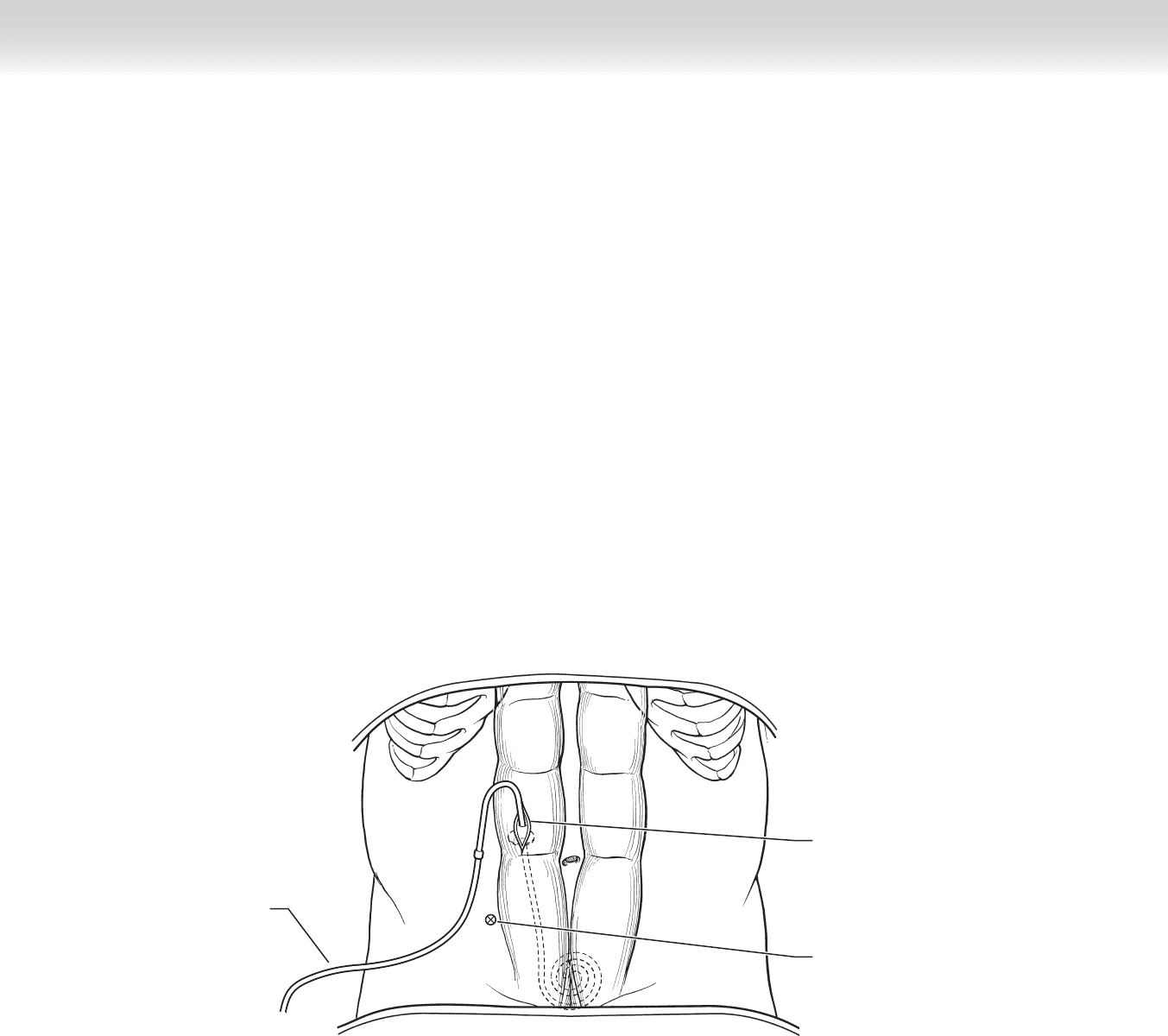
1012 Section XII • Vascular
2. DISSECTION
◆ Place the catheter over a long metal guide or stylet that has been lubricated with water-
soluble gel. Take care to look at the catheter because some have a white line that you must
keep in the anterior or “up” position. With care, place the catheter and the guide through
the hole into the peritoneal cavity. Guide the catheter along the posterior surface of the
abdominal wall toward the iliac crest. Once there, aim the catheter toward the symphysis
pubis. This allows for placement of the tip or bottom of the curl in the pelvis area close to
the abdominal wall (Figure 91-4). After removing the stylet, test the function of the cathe-
ter by instilling a dilute heparinized saline through the end of the catheter. You should be
able to instill, aspirate, and siphon the fl uid easily through the catheter without force or
interruption of fl ow. Usually, placing the patient in a reverse Trendelenburg position and
administering approximately 100 mL of fl uid aids in this maneuver.
◆ If there is diffi culty in any of these three maneuvers, reposition the catheter.
PD catheter
Upper incision
Exit site
FIGURE 91 –4
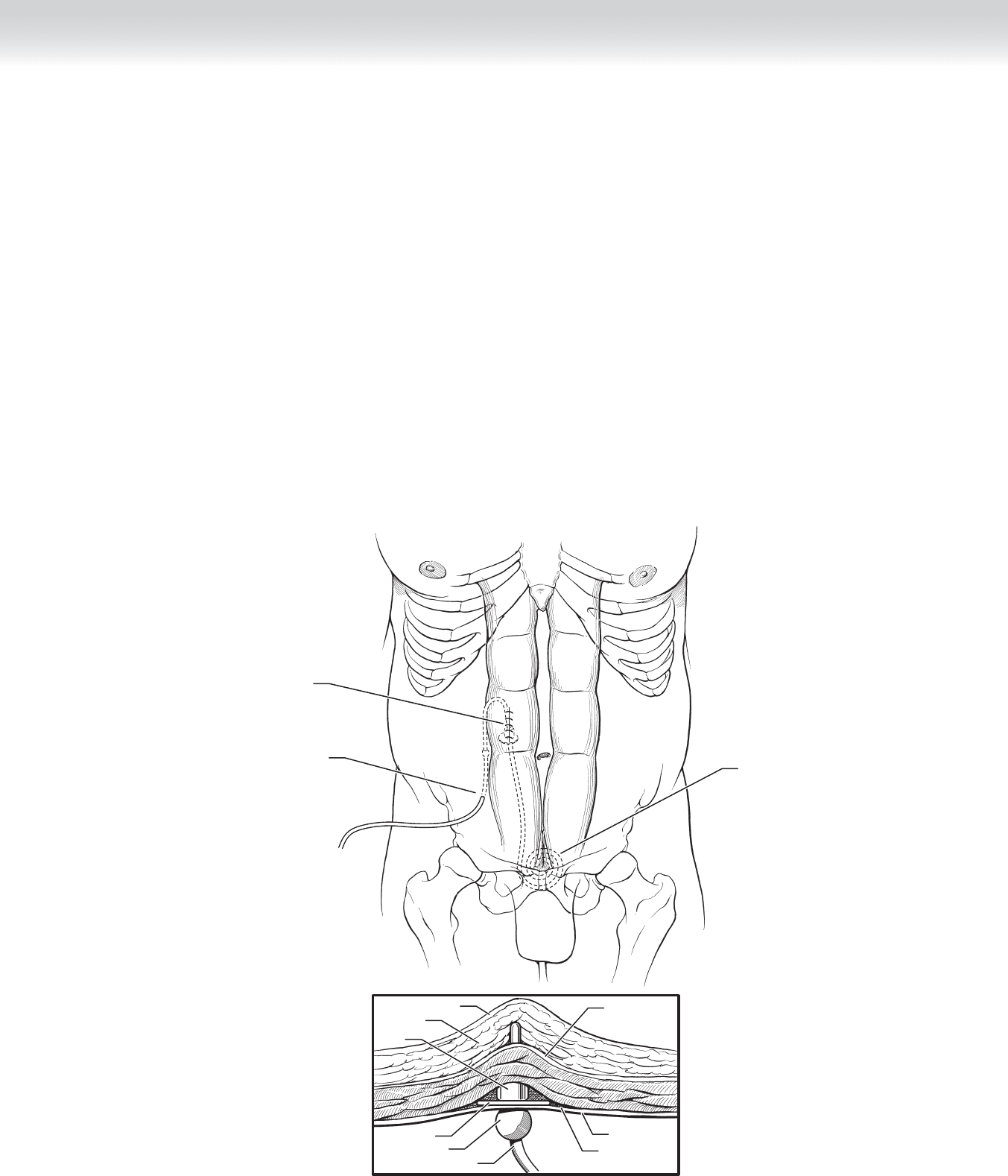
CHAPTER 91 • Insertion of Tenckhoff Catheter 1013
◆ After successfully testing the function of the catheter, tighten the purse-string around the
catheter below the cuff (or between the intraperitoneal ball and the fl at disc of the Missouri
swan-neck catheter) and suture the cuff or disc to the posterior peritoneum in a whipstitch
fashion. You must avoid puncturing the catheter with the needle (Figure 91-5).
◆ Tunnel the end of the catheter through the rectus muscle and subcutaneous tissue to the
exit site that was previously marked by the home dialysis nurse. The use of a sharp curved
trocar is best to decrease the dead space around the catheter. To decrease the incidence of
infection caused by an extruded cuff, make sure to have the second cuff of the catheter
remain in the subcutaneous space and at least 1 cm from the exit site.
3. CLOSING
◆ Close the incisions in one or two layers, as per the tradition of the institution. Do not close
the exit or place a suture around the catheter. Apply a simple clear air-permeable dressing
over the exit site and the catheter to lessen the movement of the catheter.
Exit site
Catheter in pelvis
Suture
first trocar site
Catheter in pelvis
Disc
Cuff
Skin
Ball
Fat
Anterior
rectus fascia
Peritoneum
Posterior
rectus fascia
Rectus muscle
Rectus muscle
Rectus muscle
FIGURE 91 –5
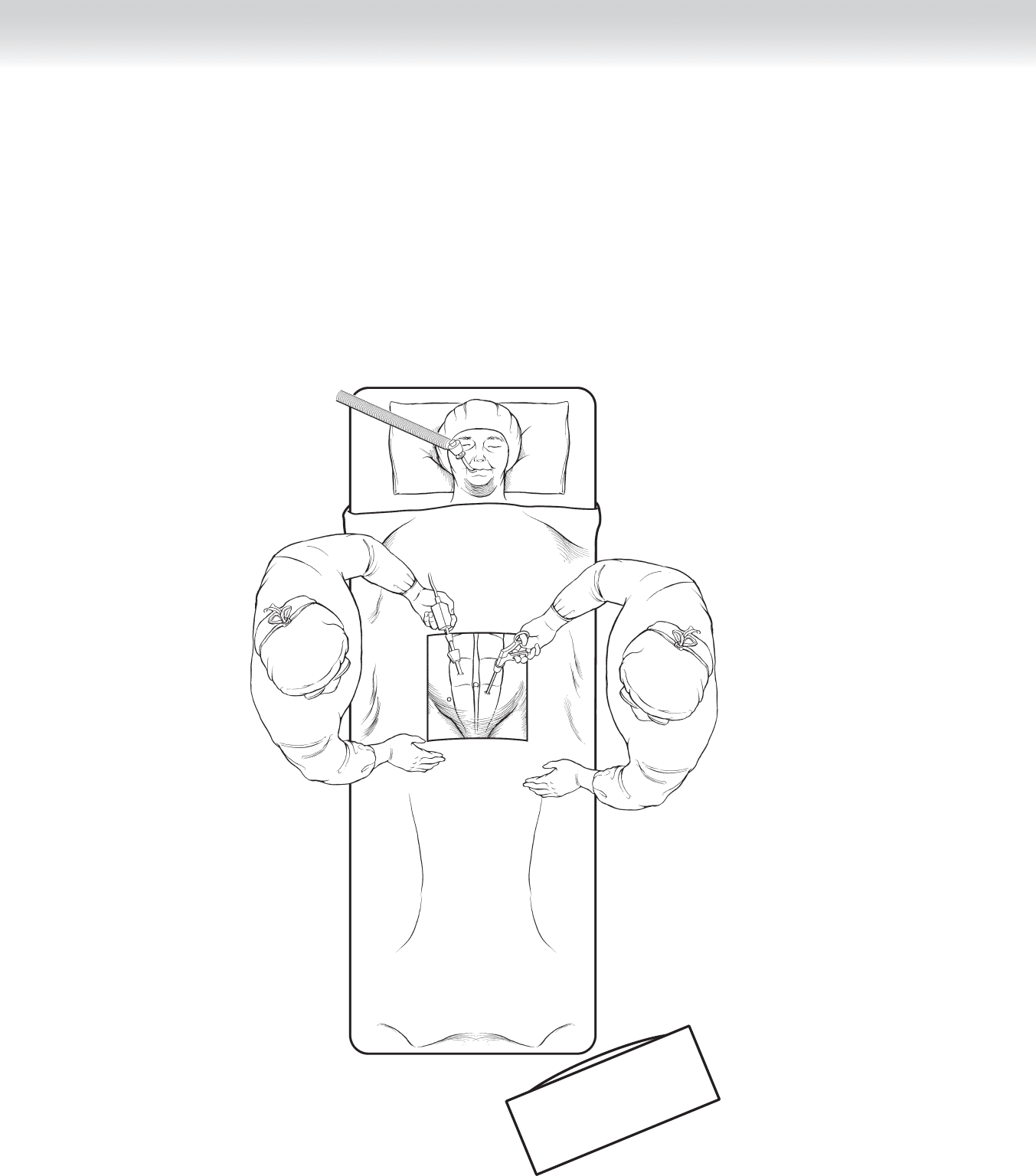
1014 Section XII • Vascular
STEP 3: OPERATIVE STEPS—LAPAROSCOPIC OPTION
◆ When using the laparoscopic techniques, the surgeon must arrange the patient and the
equipment in the most useful positions. Place the patient supine. Place the monitor at the
foot of the bed, because the pelvis is the primary area of interest and is where the tip or
the base of the curled catheter is going to lay (Figure 91-6).
Monitor
FIGURE 91–6
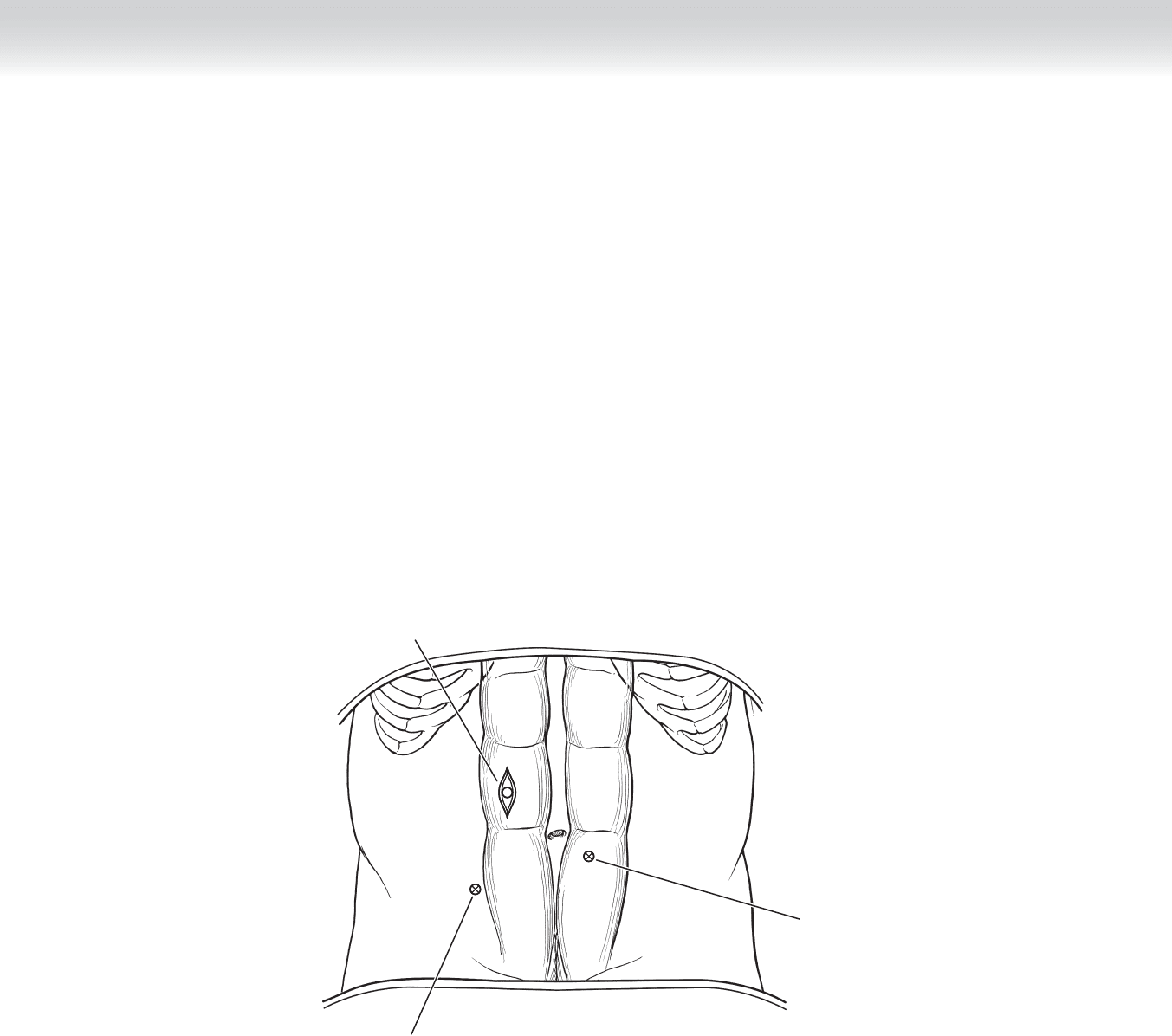
CHAPTER 91 • Insertion of Tenckhoff Catheter 1015
1. INCISION
◆ When laparoscopic assistance or laparoscopic placement only is being used, the methods
are similar to the open procedure. Place the 5-mm trocar in the most cephalad position
blindly or open as described previously (see Figure 91-7, 1). If placed open, the trocar can
be easily placed through the hole in the posterior fascia and the purse-string tightened
around the trocar (Figure 91-7). Secure the string with a rubber-shod clamp. Insuffl ate
the abdominal cavity with CO
2
to proper pressures (12 to 18 cm H
2
O pressure). Place the
5-mm camera through this trocar. An exploration of the cavity will reveal adhesions to the
abdominal wall that can be taken down with the placement of two trocars (5 mm). These
can be placed under direct vision. Place the trocars tangentially to separate the outer and
the inner holes, which allows for less leakage if the catheter is to be used quickly. One tro-
car is placed at the marked exit site (see Figure 91-7, 2) and the other in the midline or
contralateral aspect of the abdomen (see Figure 91-7, 3).
(3) Third trocar site
(1) Incision and camera site
(2) Marked area for exit site
and second trocar site
FIGURE 91 –7
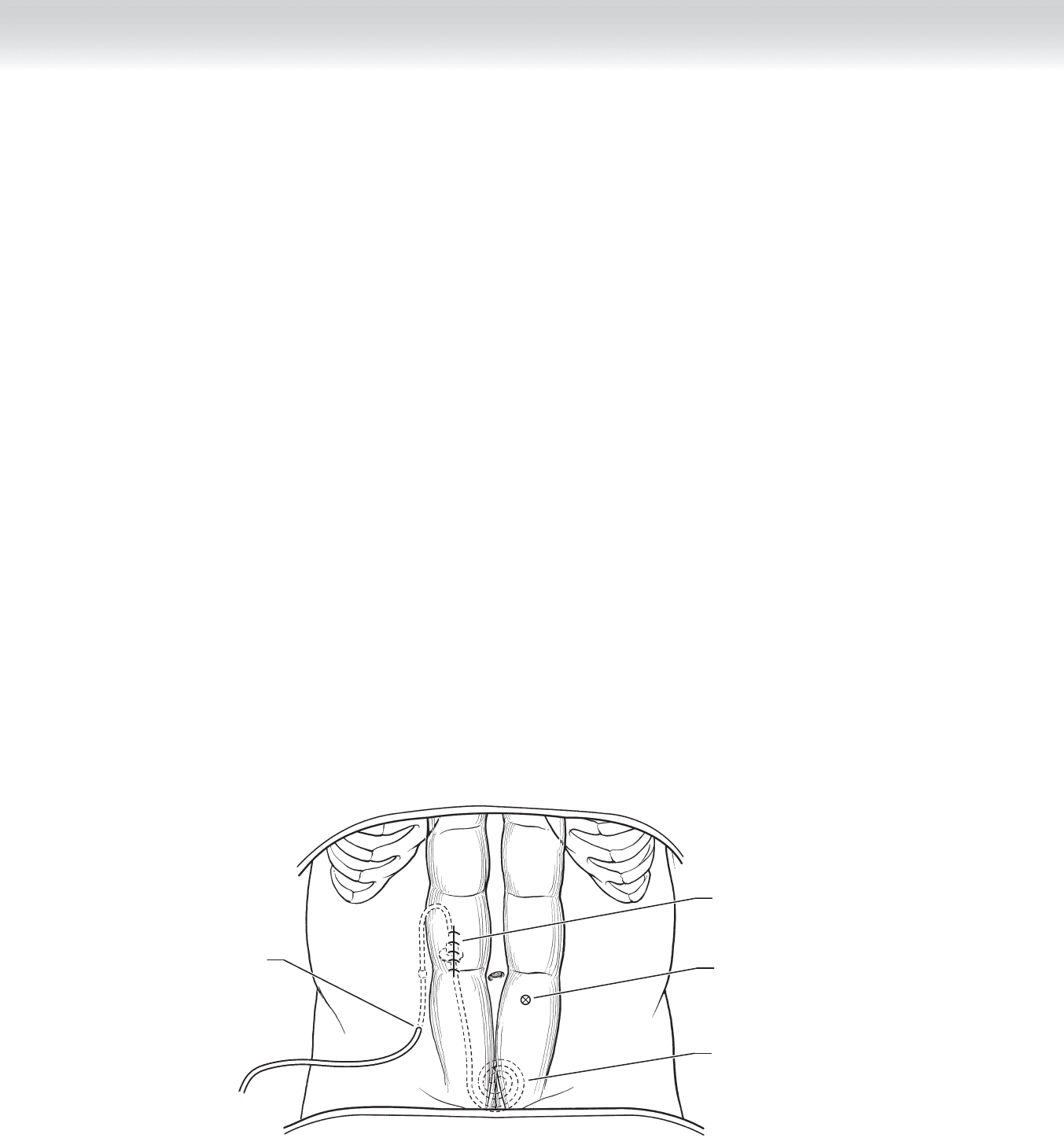
1016 Section XII • Vascular
◆ When the pelvis and lower aspect of the peritoneal cavity is free from adhesions, move the
camera to one of the other trocars. Remove the upper trocar and advance the catheter over
the stylet through the purse-string into the cavity. To decrease the loss of intra-abdominal
pressure, hold the purse-string tight around the catheter as it is advanced. Once the cuff is
at the posterior fascia, hold the suture in place with a rubber-shod clamp.
2. DISSECTION
◆ Using the camera and a grasping instrument through the remaining trocar, place the end of
the catheter (or the curl) in the pelvis above the bowel and omentum. Securing the catheter
to the posterior abdominal wall is an advantage because it prevents catheter migration and
enhances return of dialysate. Make a small incision in the skin in the midline and above the
symphysis pubis. Using a laparoscopic suture passer, pass an absorbable suture (2-0 or
larger) into the abdominal cavity under direct vision. Then guide the suture around the
catheter, at the start of the curl if using a curled catheter, or at least 5 to 8 cm above the
end of a straight catheter, and retrieve by the suture passer. Bring the suture to the outside
and then tie it down securely.
3. CLOSING
◆ The completion of this procedure is identical to the open procedure described previously
including testing for function of the catheter, securing the fi rst cuff, bringing out the end of
the catheter at the exit site, and closing the wounds (Figure 91-8).
Second trocar site
Catheter in pelvis
Closed incision
over the catheter
First trocar site
FIGURE 91 –8

CHAPTER 91 • Insertion of Tenckhoff Catheter 1017
STEP 4: POSTOPERATIVE CARE
◆ Make sure that the patients are under the care of a home dialysis program. The standard of
care is for the patient to see the dialysis nurses within 2 to 3 days. At that time, the nurses
begin to set up the schedule for the home dialysis training. Each dialysis center individual-
izes the dressings for the exit site. The nurses have protocols that are followed rigorously.
◆ Tell the patient not to swim or take baths. Taking a shower is the primary option for bathing.
◆ Give instructions to the patients regarding signs of infection and contact numbers in case
any redness, tenderness, swelling with pain, or discharge occurs at the sites of the incisions
or exit site.
◆ Use of the dialysis catheter is also individualized. If the cuff is secured to the posterior fas-
cia, the catheter can be used immediately with low volumes, increasing the volumes slowly
over several days to the therapeutic levels. Usually, the wait is 2 weeks for healing of the
incision sites and scarring of the outer cuff in the tunnel.
STEP 5: PEARLS AND PITFALLS
◆ Use the home dialysis nurses to help with the placement of the exit site. The patients have
greater satisfaction when the exit site is in a convenient spot.
◆ If the catheter cuff is secured to the posterior fascia and the 5-mm trocars are placed tan-
gentially through the abdominal wall, the likelihood of leaking is less and the catheter may
be used sooner (if not immediately).
◆ The use of the laparoscope allows the surgeon to perform other procedures, if needed
(e.g., lysis of adhesions, hernia repair, cholecystectomy, partial omentectomy).
◆ Securing the catheter to the anterior abdominal wall may prevent catheter migration and
enhance return of dialysate.
◆ Take care not to puncture the catheter outside of the abdominal cavity, because it will not
heal and you will have to place another one.
◆ Do not suture the catheter at the exit site. Place a clear, air-permeable dressing over the site
and catheter. Then call your home dialysis nurses to come re-dress the site while the patient
is in the postanesthesia care unit or the day surgery unit. The dialysis nurses are part of the
team and they are diligent about reducing the risk of infection.
SELECTED REFERENCE
1. Tsimoyiannis EC, Siakas P, Glantzounis G, et al: Laparoscopic placement of the Tenckhoff catheter for
peritoneal dialysis. Surg Laparosc Endosc Percutan Tech 2000;10:218-221.

1018
STEP 1: SURGICAL ANATOMY
◆ The target of the venous portion of the procedure is the internal jugular vein. The vein sits
in the minor supraclavicular fossa between the sternal and clavicular heads of the sterno-
cleidomastoid muscle and the clavicle and under the platysma muscle. It is encased in the
fi brous carotid sheath, independent of and anterior lateral to the carotid artery. The phrenic
nerve is posterior lateral; the ansa cervicalis crosses lateral to medial at the level of the ca-
rotid artery bifurcation and above the omohyoid muscle; and the vagus nerve is posterior
medial. On the left, under the clavicle is the thoracic duct, which crosses from medial to
lateral and enters the subclavian vein (Figure 92-1).
◆ The target of the peritoneal portion of the procedure is the peritoneum, or the confl uence
of the posterior fascia of the abdominal musculature with the peritoneum.
CHAPTER
92
Insertion of Peritoneal
Venous Shunts
Kristene K. Gugliuzza

CHAPTER 92 • Insertion of Peritoneal Venous Shunts 1019
Internal jugular vein
Common carotid artery
Omohyoid muscle
anterior belly
Anterior jugular vein
Vagus nerve
Sternocleidomastoid muscle
(clavicular head)
Sternohyoid muscle
Sternothyroid muscle
Sternocleidomastoid muscle
(sternal head)
Right recurrent
laryngeal nerve
Ansa cervicalis
External juglar vein
Phrenic nerve
Anterior scalene muscle
Sternocleidomastoid
muscle
Omohyoid muscle
posterior belly
Subclavian
artery
Right thoracic duct
Clavicle
Ansa cervicalis
External juglar vein
Phrenic nerve
Anterior scalene muscle
Sternocleidomastoid
muscle
Omohyoid muscle
posterior belly
Subclavian
artery
Internal jugular vein
Common carotid artery
Omohyoid muscle
anterior belly
Anterior jugular vein
Sternocleidomastoid muscle
(clavicular head)
Sternohyoid muscle
Sternothyroid muscle
Sternocleidomastoid muscle
(sternal head)
Vagus nerve
Left thoracic duct
Clavicle
FIGURE 92 –1

1020 Section XII • Vascular
STEP 2: PREOPERATIVE CONSIDERATIONS
◆ The patient should be placed supine with the head rotated to the contralateral side from the
planned incision. Left or right sides may be used, but care must be taken not to injure the
thoracic duct on the left. A roll or bump under the fl ank may facilitate exposure of the
lateral upper abdomen (Figure 92-2, A).
◆ If one of the jugular veins has been dissected or catheterized previously, using the other
untouched vein may be prudent.
STEP 3: OPERATIVE STEPS
1. INCISION
◆ The patient is placed supine with the head rotated to the side opposite the vein being used.
The patient is placed in a Trendelenburg position to engorge the vein by increasing the ve-
nous pressures. A roll or bump under the fl ank may facilitate exposure of the lateral upper
abdomen. The venous incision is made approximately 1 fi ngerbreadth above the clavicle
and between the two heads of the sternocleidomastoid muscle. The abdominal incision is
made lateral to the rectus muscle, approximately 2 fi ngerbreadths below the costal margin
and transversely for approximately 3 to 5 cm (Figure 92-2, B).
